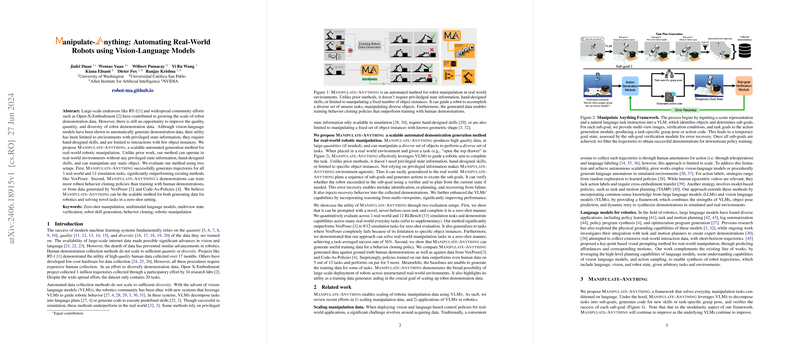Automating Real-World Robots using Vision-LLMs
The paper "Manipulate Anything: Automating Real-World Robots using Vision-LLMs" introduces an innovative method for generating automated demonstrations for real-world robotic manipulation. This technique leverages Vision-LLMs (VLMs), bypassing the need for privileged state information, hand-designed skills, or pre-defined object instances. The method is positioned as a scalable solution for both data generation in robotic training and for solving novel tasks in a zero-shot setting.
Motivation and Background
The impetus behind this research lies in the constraints posed by existing robot demonstration data collection methods. Large-scale human demonstrations are time-consuming and expensive, limiting the quantity and diversity of collected data. Although large-scale projects such as RT-1 and Open-X-Embodiment have made significant strides, their reach is restricted by human involvement and lack of variety in demonstrated tasks. The utilization of VLMs in this context presents an opportunity to automate and scale up the data collection process, rendering it more efficient and versatile.
Methodology
The proposed framework is designed to generate high-quality data for robotic manipulation, operating autonomously in varied and unstructured real-world environments. The approach involves several key steps:
- Task Plan Generation:
- The system takes a free-form language instruction and a scene image as inputs.
- A VLM identifies relevant objects and decomposes the main task into discrete sub-goals.
- Each sub-goal is associated with specific verification conditions, enhancing the system's ability to adapt and re-plan if a sub-goal fails.
- Action Generation Module:
- The module predicts low-level actions (6 DoF end-effector poses) based on the sub-goals.
- It distinguishes between agent-centric actions (modifying the robot's state) and object-centric actions (manipulating specific objects).
- For object-centric actions, it filters grasping poses using VLMs, selecting the ideal grasp based on the task's context.
- Sub-goal Verification:
- A VLM-based verifier checks if the robot's actions meet the predefined conditions for each sub-goal.
- This component uses multi-view reasoning to ensure accurate verification, mitigating errors due to occlusions or inadequate single-view information.
Experiments and Results
The paper presents an extensive evaluation through both simulated and real-world experiments:
- Simulation:
- The framework was tested on 12 diverse tasks within the RLBench environment, showcasing a broad range of manipulative actions.
- The method outperformed state-of-the-art baselines (VoxPoser and Code-As-Policies) in 9 out of 12 tasks.
- Notably, the paper reports that even without privileged state information, the system demonstrated significant robustness and adaptability.
- Behavior Cloning:
- Data generated by the proposed method was used to train behavior cloning models.
- Models trained on this data performed comparably or superior to those trained on human-generated demonstrations, highlighting the utility and quality of the autonomous data.
- Real-World Deployment:
- The system was also tested in real-world settings across five tasks, confirming its effectiveness beyond simulated environments.
- The trained policies achieved success in translating learned behaviors to physical robots, achieving task success rates up to 60%.
Implications and Future Work
The implementation of VLMs for autonomous robotic task demonstration embodies a significant evolution in scalable data collection and manipulation task automation. This method holds promise for expanding the capabilities of robotic systems to perform complex and varied tasks without human intervention, facilitating advancements in fields such as manufacturing and service robotics.
Looking forward, several areas merit further investigation:
- Enhancing zero-shot generation capabilities for more complex, multi-step tasks.
- Integrating more advanced VLMs as they evolve, leveraging their improved planning and scene understanding abilities.
- Exploring the incorporation of reinforcement learning to further refine the action generation and sub-goal verification processes.
In conclusion, this paper introduces a robust framework that substantially enhances the autonomy and scalability of robot demonstration generation, marking a meaningful contribution to the field of robotic manipulation. This approach, by leveraging state-of-the-art VLMs, stands poised to redefine the landscape of robotic learning and deployment.
